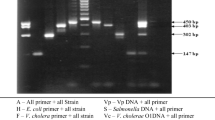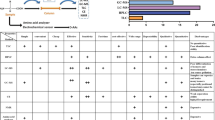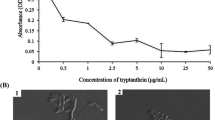Abstract
Peptides in shrimp hemolymph play an important role in the innate immune response. Analysis of hemolymph will help to detect and identify potential novel biomarkers of microbial infection. We used magnetic bead-based purification (ClinProt system) and matrix-assisted laser desorption/ionization time of flight mass spectrometry (MALDI-TOF MS) to characterize shrimp hemolymph peptides. Shrimp serum and plasma were used as the source of samples for comparative analysis, and it was found that serum was more suitable for shrimp hemolymph peptidomic analysis. To screen potential specific biomarkers in serum of immune-challenged shrimps, we applied magnetic bead-based MALDI-TOF MS to serum samples from 10 immune-challenged and 10 healthy shrimps. The spectra were analyzed using FlexAnalysis 3.0 and ClinProTools 2.1 software. Thirteen peptide peaks significantly different between the two groups were selected as candidate biomarkers of lipopolysaccharide (LPS)-infection. The diagnostic model established by genetic algorithm using five of these peaks was able to discriminate LPS-challenged shrimps from healthy control shrimps with a sensitivity of 90% and a specificity of 100%. Our approach in MALDITOF MS-based peptidomics is a powerful tool for screening bioactive peptides or biomarkers derived from hemolymph, and will help to enable a better understanding of the innate immune response of shrimps.
Similar content being viewed by others
References
Albrecht W. 2005. Clinprot, an expandable platform for biomarker discovery. Molecular and Cellular Proteomics, 4(8): S387–S387.
Antony S P, Singh I S B, Philip R. 2010. Molecular characterization of a crustin-like, putative antimicrobial peptide, Fi-crustin, from the Indian white shrimp, Fenneropenaeus indicus. Fish and Shellfish Immunology, 28(1): 216–220.
Baumann S, Ceglarek U, Fiedler G M, Lembcke J, Leichtle A, Thiery J. 2005. Standardized approach to proteome profiling of human serum based on magnetic bead separation and matrix-assisted laser desorption/ionization time-of-flight mass spectrometry. Clinical Chemistry, 51(6): 973–980.
Bosso N, Chinello C, Picozzi S C M, Gianazza E, Mainini V, Galbusera C, Raimondo F, Perego R, Casellato S, Rocco F, Ferrero S, Bosari S, Mocarelli P, Kienle M G, Magni F. 2008. Human urine biomarkers of renal cell carcinoma evaluated by ClinProt. Proteomics Clinical Applications, 2(7–8): 1 036–1 046.
Cheng W, Tsai I H, Huang C J, Chiang P C, Cheng C H, Yeh M S. 2008. Cloning and characterization of hemolymph clottable proteins of kuruma prawn (Marsupenaeus japonicus) and white shrimp (Litopenaeus vannamei). Developmental and Comparative Immunology, 32(3): 265–274.
Chiou T T, Wu J L, Chen T T, Lu J K. 2005. Molecular cloning and characterization of cDNA of penaeidin-like antimicrobial peptide from tiger shrimp (Penaeus monodon). Marine Biotechnology, 7(2): 119–127.
Cuthbertson B J, Deterding L J, Williams J G, Tomer K B, Etienne K, Blackshear P J, Bullesbach E E, Grosse P S. 2008. Diversity in penaeidin antimicrobial peptide form and function. Developmental and Comparative Immunology, 32(3): 167–181.
FigueroaSoto C G, delaBarca A M C, VazquezMoreno L, HigueraCiapara I, YepizPlascencia G. 1997. Purification of hemocyanin from white shrimp (Penaeus vannamei Boone) by immobilized metal affinity chromatography. Comparative Biochemistry and Physiology B-Biochemistry and Molecular Biology, 117(2): 203–208.
Flegel T W, Sritunyalucksana K. 2011. Shrimp molecular responses to viral pathogens. Marine Biotechnology, 13(4): 587–607.
Hauton C, Brockton V, Smith V J. 2007. Changes in immune gene expression and resistance to bacterial infection in lobster (Homarus gammarus) post-larval stage VI following acute or chronic exposure to immune stimulating compounds. Molecular Immunology, 44(4): 443–450.
Huang B X, Zhang J Q, Xiang J H. 2008. Purification and primary identification of haemocyanin in the Chinese shrimp, Fenneropenaeus chinensis (Decapoda, Penaeoidea). Crustaceana, 81(7): 769–780.
Kang C, Wang J, Zhao X, Yang X, Shao H, Xiang J. 2004. Molecular cloning and expression analysis of Chpenaeidin, an antimicrobial peptide from Chinese shrimp, Fenneropenaeus chinensis. Fish and Shellfish Immunology, 16(4): 513–525.
Levy F, Bulet P, Ehret-Sabatier L. 2004. Proteomic analysis of the systemic immune response of Drosophila. Molecular and Cellular Proteomics, 3(2): 156–166.
Liu F S, Liu Y C, Li F H, Dong B, Xiang J H. 2005. Molecular cloning and expression profile of putative antilipopolysaccharide factor in Chinese shrimp (Fenneropenaeus chinensis). Marine Biotechnology, 7(6): 600–608.
Magni F, Van Der Burgt Y E M, Chinello C, Mainini V, Gianazza E, Squeo V, Deelder A M, Kienle M G. 2010. Biomarkers discovery by peptide and protein profiling in biological fluids based on functionalized magnetic beads purification and mass spectrometry. Blood Transfusion, 8: S92–S97.
Perazzolo L M, Lorenzini D M, Daffre S, Barracco M A. 2005. Purification and partial characterization of the plasma clotting protein from the pink shrimp Farfantepenaeus paulensis. Comparative Biochemistry and Physiology B-Biochemistry and Molecular Biology, 142(3): 302–307.
Qiu F, Liu H Y, Zhang X J, Tian Y P. 2009. Optimization of magnetic beads for MALDI-TOF MS analysis. Frontiers in Bioscience, 14: 3 712–3 723.
Robalino J, Almeida J S, McKillen D, Colglazier J, Trent H F, Chen Y A, Peck M E T, Browdy C L, Chapman R W, Warr G W, Gross P S. 2007. Insights into the immune transcriptome of the shrimp Litopenaeus vannamei: tissue-specific expression profiles and transcriptomic responses to immune challenge. Physiological Genomics, 29(1): 44–56.
Rowley A F, Powell A. 2007. Invertebrate immune systemsspecific, quasi-specific, or nonspecific? Journal of Immunology, 179(11): 7 209–7 214.
Schuerenbeg M, Luebbert C, Eickhoff H, Kalkum M, Lehrach H, Nordhoff E. 2000. Prestructured MALDI-MS sample supports. Analytical Chemistry, 72(15): 3 436–3 442.
Somboonwiwat K, Chaikeeratisak V, Wang H C, Lo C F, Tassanakajon A. 2010. Proteomic analysis of differentially expressed proteins in Penaeus monodon hemocytes after Vibrio harveyi infection. Proteome Science, 8: 39.
Sun J, Wang L, Wang B, Guo Z, Liu M, Jiang K, Luo Z. 2007. Purification and characterisation of a natural lectin from the serum of the shrimp Litopenaeus vannamei. Fish and Shellfish Immunology, 23(2): 292–299.
Sun J, Wang L, Wang B, Guo Z, Liu M, Jiang K, Tao R, Zhang G. 2008. Purification and characterization of a natural lectin from the plasma of the shrimp Fenneropenaeus chinensis. Fish and Shellfish Immunology, 25(3): 290–297.
Timms J F, Arslan-Low E, Gentry-Maharaj A, Luo Z, T’Jampens D, Podust V N, Ford J, Fung E T, Gammerman A, Jacobs I, Menon U. 2007. Preanalytic influence of sample handling on SELDI-TOF serum protein profiles. Clinical Chemistry, 53(4): 645–656.
Uttenweiler-Joseph S, Moniatte M, Lagueux M, Van Dorsselaer A, Hoffmann J A, Bulet P. 1998. Differential display of peptides induced during the immune response of Drosophila: A matrix-assisted laser desorption ionization time-of-flight mass spectrometry study. Proceedings of the National Academy of Sciences of the United States of America, 95(19): 11 342–11 347.
Vierstraete E, Verleyen P, De Loof A, Schoofs L. 2005. Differential proteomics for studying Drosophila immunity. Trends in Comparative Endocrinology and Neurobiology, 1040: 504–507.
West-Norager M, Kelstrup C D, Schou C, Hogdall E V, Hogdall C K, Heegaard N H H. 2007. Unravelling in vitro variables of major importance for the outcome of mass spectrometry-based serum proteomics. Journal of Chromatography B-Analytical Technologies in the Biomedical and Life Sciences, 847(1): 30–37.
Yao C, Wu C, Xiang J, Dong B. 2005. Molecular cloning and response to laminarin stimulation of arginine kinase in haemolymph in Chinese shrimp, Fenneropenaeus chinensis. Fish and Shellfish Immunology, 19(4): 317–329.
Author information
Authors and Affiliations
Corresponding author
Additional information
Supported by the National Natural Science Foundation of China (No. 30600458)
Rights and permissions
About this article
Cite this article
Wang, B., Liu, M., Jiang, K. et al. Peptidomic analysis of Chinese shrimp (Fenneropenaeus chinensis) hemolymph by magnetic bead-based MALDI-TOF MS. Chin. J. Ocean. Limnol. 31, 407–415 (2013). https://doi.org/10.1007/s00343-013-2076-4
Received:
Accepted:
Published:
Issue Date:
DOI: https://doi.org/10.1007/s00343-013-2076-4




